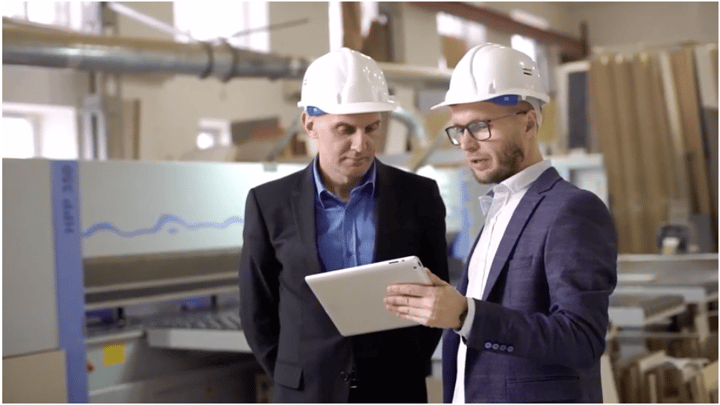ARCHIVE FOR THE ‘iot-2’ CATEGORY
Jun 11, 2019 • Features • future of field service • Oneserve • IoT • Service Automation
The impact of technology has been felt far beyond service. Homeserve’s Paul Joesbury worked in finance before joining the utility company “I look back and reflect on my time in finance,” he recalls, “many of the tasks were done manually, like ledger reconciliations, which are all automated now. Previously it would take a bank of humans that would take the best part of a week to reconcile something and now it’s pretty much done with the touch of a button.”
The Operation Manager continues, adamant that his current sector should benefit from the same progress “So why should service operations be different? The technology, I think, is pretty much already there. It’s how it can be applied in a cost-effective way which is going to be the challenge for organisations.”
Chris Proctor is another great believer in technology but he suggests firms should adopt technology for the right reasons. “A lot of companies are trialing new technology at the moment, but it comes down to when it is absolutely necessary, and at what point does the use-case become really tried and really tested.” However, the Oneserve CEO is concerned about the pace of adoption generally in the sector. “I might be lambasted for saying this but I don’t think there has been much innovation,” he says, aware of the statement’s brevity. “It’s disappointing that the last real innovation in field service management was moving to the cloud and even then, I don’t think everyone is fully there yet.”
It’s a bold claim, yet one that has substance. The industry has been accused before of lagging when it comes to embracing disruptive, digital technology. “I think one of the biggest problems the industry has is properly understanding the trajectory of new technology,” he explains. “There’s this concept of necessity being the mother of all inventions and I think there’s a really good point in that. A lot of industries and a lot of sectors are having to go through a lot of change. In the UK there’s so much uncertainty in so many pockets at the moment, trying to make big decisions on how you engage with new technologies is very difficult.”
It’s a sentiment echoed by Joesbury who feels the role of technology will slowly phase out that of the engineer...but not quite yet. “I definitely think in five years’ time that there will still be humans around,” he ponders, “but I think we’ll be doing different roles, and I think the important aspect over the next five years is to learn to trust the technology and equally for the technology to work and we’ve got to embrace that. After that you’re on a journey searching for the next big leap of faith but where does it come from? I’m not sure if service operations is going to be the market leader in this space, but I definitely can see lots of value potential, I think we just have to open our hearts a little bit and embrace it.”
"The impact of technology has been felt far beyond service..."
The society that technology operates in can also influence how it is executed. We are on the cusp of a younger generation who expect everything to work first time. The way in which people communicate is also changing, to a point where digital messaging is superseding vocal interaction.
If the trend is to continue then service will have to adapt to this way of communicating and reflect that in its technology usage. Where does Proctor see the service sector heading? Will there be a fundamental shift in approach as more young people enter the arena? Servitization and the gig economy, he predicts, will have an impact on the way services are delivered. Most likely through a subscription-based model, complimented by disruptive innovations and delivered by freelancers who, in order to maintain their personal brand, deliver consistent service excellence. “I can see a world where most of your services are consumed on a subscription-type basis. You contact your service provider who then uses technology similar to programmatic advertising whereby contracts are tended and bid for and secured within seconds, all underpinned by blockchain.” he says.
The role of blockchain in IoT and its evolution will surely be an important one. As more devices connect with one another than security becomes more of an issue, however Blockchain could provide the ring fence Iot needs. However, Proctor, a passionate advocate for blockchain, wants quicker adoption. “I think there are lots and lots of limitations of how we are going to bring [blockchain] in,” he says. “In exactly the same way that iOT and AI is a technology set that people don’t fully understand. There is a lot of hype around how it can help service but when you scratch under the surface, it’s just a hypothesis,” he pauses, “it has the ability to be truly, truly game changing.”
Blockchain, IoT and AI are all huge potential disruptors in the service sector. IoT could, over the next few years, become something that pushes the boundaries of what we now see as traditional service. As Paul Joesbury said, it’s about “trusting and embracing what is available”. Perhaps then will we witness a number of game changing moments.
Game on!
May 28, 2019 • News • 5G • future of field service • Berg Insight • IoT
The first 5G cellular IoT modules will become available to developers this year, enabling early adopters to create the first IoT devices based on the standard. Based on the experience of previous introductions of new standards, 5G will however not be an instant hit. By 2023, Berg Insight forecasts that 5G will account for just under 3 percent of the total installed base of cellular IoT devices.
“5G still has some way to go before it can become a mainstream technology for cellular IoT”, says Tobias Ryberg, Principal Analyst and author of the report. “Just like 4G when it was first introduced, the initial version of 5G is mostly about improving network performance and data capacity. This is only relevant for a smaller subset of high-bandwidth cellular IoT applications like connected cars, security cameras and industrial routers. The real commercial breakthrough will not happen until the massive machine type communication (mMTC) use case has been implemented in the standard.”
mMTC is intended as an evolution of the LTE-M/NB-IoT enhancements to the 4G standard. Since NB-IoT has only just started to appear in commercial products, there is no immediate demand for a successor. Over time, fifth generation mobile networks will however become necessary to cope with the expected exponential growth of IoT connections and data traffic.
The report identifies homeland security as an area where 5G cellular IoT can have a major impact already in the early 2020s. “5G enables the deployment of high-density networks of AI-supported security cameras to monitor anything form security-classified facilities to national borders or entire cities”, says Mr. Ryberg. “How this technology is used and by whom is likely to become one of the most controversial issues in the next decade.”
May 23, 2019 • video • Features • Astea • Kris Oldland • manufacturing • Video • field service • Internet of Things • IoT • Servitization • John Hunt
May 16, 2019 • video • Features • Astea • Kris Oldland • manufacturing • Video • field service • Internet of Things • IoT • Servitization • John Hunt
May 09, 2019 • video • Features • Astea • Kris Oldland • manufacturing • Video • field service • Internet of Things • IoT • Servitization • John Hunt
May 08, 2019 • News • future of field service • research report • IoT
The enterprise asset management systems market is expected to be valued at US$ 4,863.1 Mn in 2028, and is expected to register a CAGR of 7.7% from 2018 to 2028, a new report shows.
Improved ROI with the aid of EAM solutions, widespread penetration of IoT and gradual increase in investment on software by organisations are expected to remain the major factors driving growth of the global enterprise asset management systems market, a report shows.
Enterprise asset management software is primarily used by the enterprises across different industry verticals which are heavily dependent on the complex and expensive physical assets, such as plants, heavy equipment, and vehicles. End users of the EAM primarily include industries such as oil & gas, manufacturing, energy & utility, mining, and others. Enterprise asset management software is offered with the deployment options such as on-premise and cloud based.
Enterprise asset management systems market is categorized on the basis of component, deployment, vertical and region. On the basis of component, the market is segmented as solution and services. The services segment is further bifurcated into consulting services and professional services. The services segment is expected to register a CAGR of 7.8% during the forecast period.
On the basis of deployment, the enterprise asset management systems market is segmented into on-premise and cloud. The revenue contribution from the clouds segment is expected to expand at a CAGR of 9.0% during the forecast period.
On the basis of vertical, enterprise asset management systems market is segmented as public sector, manufacturing, oil and gas, healthcare and pharmaceutical industry, energy and utility, transportation, wholesale and distribution, food and beverages, paper and packaging, chemical and process industry (including steel industry), mining and service industry. The revenue contribution from the manufacturing segment is expected to expand at a CAGR of 9.4% during the forecast period.
Among the regions, North America is projected to exhibit relatively high growth in the global market, registering a CAGR of 9.3% over the forecast period. The revenue from the markets in North America and Western Europe are expected to represent a combined share of 45.3% of the total market revenue by the end of forecast period. Some of the top companies identified across the Enterprise Asset Management Systems value chain are IBM Corporation, SAP SE, Oracle Corporation, ABB Ltd, IFS Ltd, Infor Inc., Ultimate Software Solutions BV, Carl International SA, Mainsaver Inc., Mex Pty Ltd and others.
May 07, 2019 • Features • future of field service • IoT
The promise of IoT has been vast and they hyperbole around it’s impact on field service delivery are massive – but is it actually living up to the hype and what more should we expect? Kris Oldland discusses...
The promise of IoT has been vast and they hyperbole around it’s impact on field service delivery are massive – but is it actually living up to the hype and what more should we expect? Kris Oldland discusses...
The early hype and industry trends
The story of IoT’s rapid rise and how it went from the top of the hype cycle straight to a standard part of industry is now well documented. Indeed, across the last two years, I don’t think I can recall a single service executive I’ve met whose organization isn’t at least seeking to implement some layer of IoT connectivity into their field service operation - many are already far down the path.
On the surface, it certainly seems that IoT is living up to its billing as “the most over-hyped technology in development today” a moniker which heavyweight analysts Gartner applied to it not too long ago.
Back in the misty past of 2014, the official line from Gartner was that IoT was ‘five to 10 years from actual productivity.’ Back then IoT was riding the crest of the “peak of inflated expectations” within the analyst’s much loved, if slightly overly poetic, hype cycle.
So as we hit the closest limits of that prediction perhaps now is a good time to establish if IoT is still on track to revolutionize the world, and in particular field service, as Gartner and others - including myself, so boldly predicted.
Back in 2014, it was a lack of standardization in the area, as well as the changing nature of the technology itself, which Gartner identified as part of the reason why widespread adoption was further away than its promoters at the time may have thought.
“Standardization (data standards, wireless protocols, technologies) is still a challenge to morerapid adoption of the IoT,” wrote Gartner’s Hung LeHong.
“A wide number of consortiums, standards bodies, associations and government/region policies around the globe are tackling the standards issues. Ironically, with so many entities each working on their own interests, we expect the lack of standards to remain a problem over the next three to five years.”
Indeed, within field service this has become something over a common theme as we have seen the technology move from an embryonic to fledgling state.
It was interesting to note for example IFS’s approach in the area was not to develop a specific propitiatory IoT solution as some of their peers in the field service management arena, such as PTC and ServiceMax had veered towards, but instead opted to bring to market an IoT connector, that was able to plug the gap between whichever IoT protocol an organization favored and their field service platform.
This type of approach, of providing some form of sorting house for various data formats has since been impressively taken up by the like of Microsoft and others also - and may well point to the where the future lies for field service companies leveraging IoT in the future.
How IoT is being adopted and outlining connected field service
Before, we can assess if IoT is as yet hitting its potential as a fundamental bedrock for twenty first century field service, perhaps we should take a moment to look at some of the key areas in which it will be applied.
As with almost any technology that makes it at the corporate grade, the first thing that everyone gets excited is the financials.
For a long time the dual challenge for field service operations has been the seemingly incompatible tasks of improving CSAT levels and reducing costs. For those service directors trying to manage this impossible equilibrium, early talk of the magic bullet of IoT would have sounded like a divine panacea, with talk about how IoT could improve both profitability and customer relationships, being at first whispered in hushed tones, before being shouted loudly from the roof tops when the first few actual cases studies started to emerge.
Within these case studies there were invariably four key areas of success:
Automation
Rather than the customer having to report problems, IoT-enabled devices can automatically contact the technician directly with specific details of the issue. The technician can then arrive with knowledge and parts to immediately solve the problem.
Reduced Inspections
Devices capable of self-diagnosing issues and reporting on performance, not only reduce the need for customers to contact technicians, they also cut down on the amount of inspections required to solve an issue.
Inventory Management
IoT-enabled devices that require servicing or new parts, now automatically flag these issues to technicians for attention. Alongside this, technicians can also connect directly to the warehouse for instant, real-time inventory data to check whether the parts needed are in stock.
Redefine ‘Service’
Rather than simply fixing devices that already have maintenance issues, IoT is enabling serviceproviders to see and solve customer problems before they even occur. This is thanks to real-time performance data that can signal when parts are on the verge of needing replacement or interpret the signs of potential maintenance issues. A case could be made for how each of the first three of these developments could be considered something of a revolution within the field service sector. Machines that can self diagnose their faults, order the parts they need to remedy the problem and arrange for a human co-worker to come out and make the necessary repairs all sound like something from the future - and even better it is a nice happy Jetson-eque vision of the future, rather than the bleaker dystopian version that sells Hollywood movies. However, it is the fourth of these points, i.e. Redefining Service, where perhaps the true potential of IoT is uncovered.
The fundamental role IoT is playing in servitization.
In a world of exaggerated hyperbole, it is perhaps only natural to dismiss the talk of a fourth industrial paradigm that accompanies the discussion around Servitization as overegging the pudding somewhat.
At the risk of sounding like a bad pastiche of industry journalist though, I think that such talk is actually pretty much on the money. I do however, think there is there is a long way to go before we get there - and for me IoT is the fundamental technology that is required for a company to fully move into a servitized business strategy.
Wait! I here you cry, Rolls Royce, MAN UK, Caterpillar - they were all doing servitization before the IoT was even an apple in its developer’s eyes.
This is of course, very true, but at its essence all IoT has simply done is make the bespoke telematics of true innovative giants such as those listed above (and the other handful of pioneering poster boys of servitization) available on mass scale. Power by the Hour is all about the data, as is the IoT.
A simplification perhaps, but one that is founded in truth and whilst the move towards preventative maintenance, that is commonly mentioned in the same breath as IoT, isn’t servitization, it is a fundamental step towards the strategy - which is one that is becoming more and more prevalent in almost all vertical sectors.
Great Expectations:
So to answer the question in the title of this article - yes, I believe that IoT is so far living up to its potential as a revolutionary game changer within our sector. That said, I don’t think it is greedy to expect even more. As ServiceMax CEO Scott Berg discussed in a recent interview with Field Service News, there is certainly more to come from IoT in terms of the way field service companies are leveraging it.
“I think what needs to happen now, and where the real value will come from IoT, is when input from a machine can be fed into more predictive models using Artificial Intelligence (AI) and Machine Learning. Only then we will get truly predictive services, and only then will you get a learning model rather than an alert system.”
He commented. Essentially, I think Gartner got their 2014 timeframe pretty much spot on. Five years on from that prediction and we are now generally seeing fully functioning IoT systems in place quite commonly amongst field service organizations, but I think it will be at least a further five years before those systems mature to become close to their full potential.
The analogy of PCs in the workplace comes to mind. For those companies who embraced early DOS systems, they gained an important head-start on their peers who stubbornly ignored that particular wave of technological innovation. Yet, by the time Windows 95 had emerged the technology was not only pretty much universal but had become ingrained into the fabric of industry at all levels.
Expect the same of IoT in 2025.
May 03, 2019 • News • future of field service • Oil and Gas • Berg Insight • IoT
According to a new research report from the M2M/IoT analyst firm Berg Insight, the number of devices featuring cellular or satellite connectivity deployed in oil and gas applications amounted to 1.3 million at the end of 2018.
According to a new research report from the M2M/IoT analyst firm Berg Insight, the number of devices featuring cellular or satellite connectivity deployed in oil and gas applications amounted to 1.3 million at the end of 2018.
Growing at a compound annual growth rate (CAGR) of 6.8 percent, this number is expected to reach 1.9 million units by 2023. Remote monitoring of tanks and industrial equipment in the midstream and downstream sectors comprise the most common applications for wireless solutions in the oil and gas industry. Berg Insight expects that shipments in the upstream sector will grow faster, although from a much smaller base, as cellular communications become an increasingly viable alternative to proprietary radio due to improved 4G LTE coverage in North America and broader support from the industry.
While the market has been affected by the decrease in oil prices in recent years, significant developments have taken place in regard to the industry landscape and technological advances. Major automation vendors such as Emerson, Siemens, Schneider Electric, Yokogawa, Honeywell and ABB are investing heavily in the development of software platforms to support use cases surrounding predictive analytics and digital twins. Recent developments further include Rockwell Automation’s joint venture agreement with the major oilfield service company Schlumberger to create Sensia, an integrated automation solution provider in the oil and gas industry. On the communications side, several initiatives have been launched to promote the adoption of cellular technologies in the utilities industry, primarily in the US. In early 2019, leading cellular device providers, including Sierra Wireless, Cisco, MultiTech Systems, GE and Encore Networks together with spectrum licensees and utilities formed the Utility Broadband Alliance (UBBA) to advance the development of private LTE networks for critical infrastructure industries.
Solutions for remote monitoring of assets such as wellheads, storage tanks and pipeline infrastructure are offered by major industrial automation vendors, as well as a large number of specialised providers. “Key consolidators in the market for remote monitoring solutions are the private equity held companies Quorum Software and DataOnline that have acquired six and three businesses respectively between 2015–2019”, said Fredrik Stalbrand, IoT Analyst, Berg Insight. He mentions recent deals such as Quorum’s acquisitions of the Coastal Flow Measurement family of companies and Flow-Cal in March 2019, as well as DataOnline’s purchase of Sierra Wireless’ iTank business in December 2018. Important vendors that specialise in remote SCADA and tank monitoring further include AIUT, Critical Control, eLynx Technologies, Silicon Controls, SkyBitz, WellAware, Zedi and ZTR Control Systems. “Several players continue to have inorganic growth as a key strategy, so further M&As can be expected among IIoT solution providers targeting the oil and gas industry in 2019–2020”, concluded Mr. Stalbrand.
You can read the full report here.














 Field Service News is published by 1927 Media Ltd, an independent publisher whose sole focus is on the field service sector. As such our entire resources are focused on helping drive the field service sector forwards and aiming to best serve our industry through honest, incisive and innovative media coverage of the global field service sector.
Field Service News is published by 1927 Media Ltd, an independent publisher whose sole focus is on the field service sector. As such our entire resources are focused on helping drive the field service sector forwards and aiming to best serve our industry through honest, incisive and innovative media coverage of the global field service sector.
Leave a Reply